The March Madness you’ve never heard of
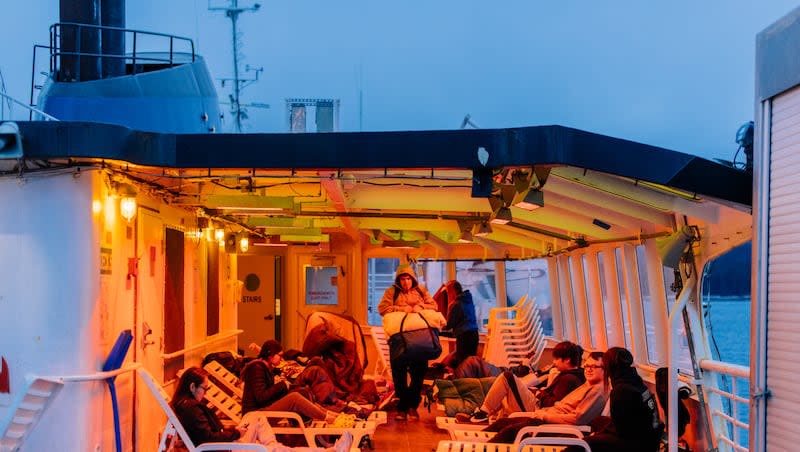
It’s a clear nigh for a sail — a rarity for the Alaskan winter — as the ferry cleaves its way between inky mountain silhouettes. Samara Kasayulie-Kookesh sits silently in a white pool chair, braiding her sister Cheyenne’s black hair. Her fingers move deftly despite the cold; she’s accustomed to the frigid darkness. This is a journey she’s been making since before she could walk.
Ferries like this one, the MV LeConte, connect Southeast Alaska’s stretch of remote islands — home to the Tlingit and Haida — to jobs, groceries and conveniences taken for granted on the mainland. But tonight, the ferry is headed to Juneau for something special, for a tradition over a half-century in the making. Tonight, this boat is carrying Samara and her sister to a basketball tournament.
Tipping off shortly after the end of World War II, the Lions Club Gold Medal Basketball Tournament is one of the longest-running amateur sports tournaments in the country. Every March for over 75 years, thousands of Southeast Alaskans pack the gym at Juneau-Douglas High School for a week of games spread across four divisions. It’s a rowdy celebration of sport and culture, bringing together a geographically splintered community for annual bragging rights. While most of the country has its eyes on the NCAA’s March Madness farther south, for a primarily Indigenous community isolated for most of the year, the Gold Medal has become a rallying point much bigger than the game itself.
Back on the MV LeConte, a maze of air mattresses and blankets covers the cabins and sprawls across the ferry deck. Kids, grandparents and village rivals from Hoonah, Kake and the Kookesh’s Angoon pack the LeConte. While high schoolers will occasionally crisscross these waters for league games, this vessel follows an extended, once-a-year tournament route, winding eight hours through icy straits to deliver teams to Alaska’s state capital by sunrise.
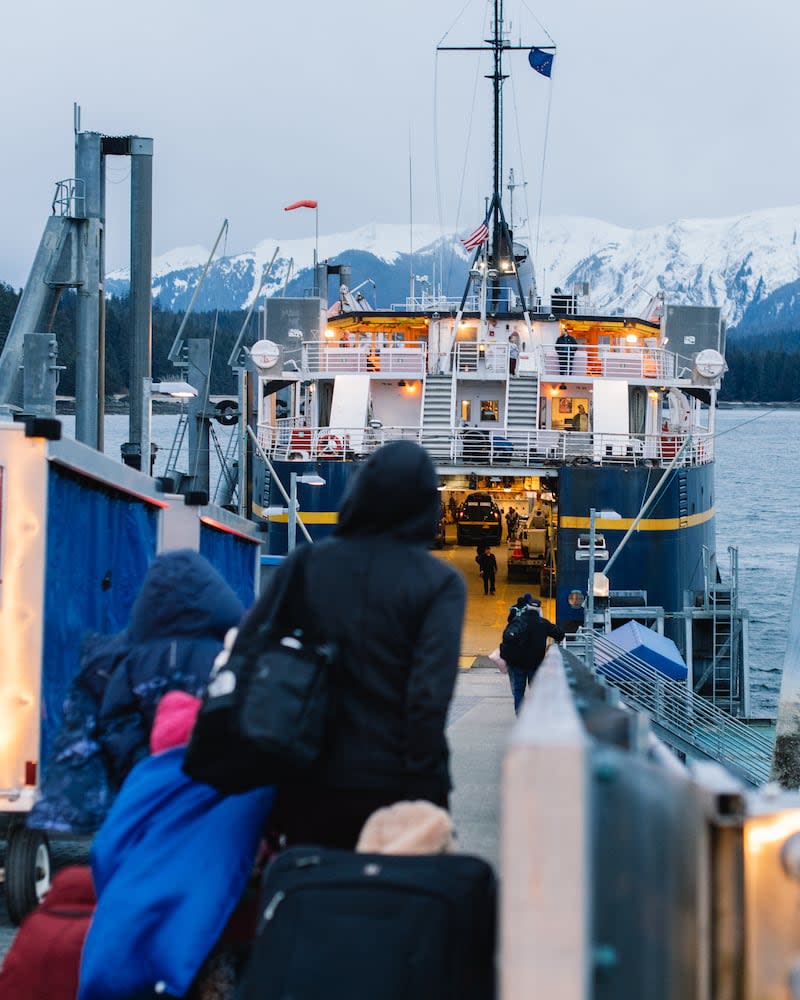
Samara, 20, a sophomore at Arizona’s Grand Canyon University, skipped spring break to fly in for the games. Even though she and her 18-year-old sister grew up shooting hoops on cracked driveways and later for Angoon’s high school team, it will be their first time playing as Gold Medal athletes together. It’s not their first Gold Medal ferry, however, as the pair has made the pilgrimage to watch cousins, aunts, uncles and even grandparents take the tournament floor. Their late grandfather, Albert Kookesh, helped lead Angoon to 11 Gold Medal championships over three decades. Their father, and their tiny fishing town’s former mayor, Albert Kookesh III, is coming out of retirement to play in this year’s masters division. The Kookeshes aren’t unique in that regard. In the belly of the LeConte, handfuls of families can trace their Gold Medal history across multiple generations.
In the Alaskan night, Samara’s shoulders look unencumbered, light, even. With tomorrow’s tourney tipoff and Juneau’s Auke Bay Ferry Terminal still a few hours out, she cracks a quick joke with her sister and friends. There’s no mention of history, of games, or even basketball for that matter, but the fact that she’s floating here, multiple flights from the comfort of her college dorm, reflects a calling her grandfather once canonized for hundreds of Gold Medal faithful.
“(This tournament) is a religious journey to us,” he said. “Muslims go to Mecca, and each March, we go to Juneau.”
“Basketball is where we go to be social. We don’t have nightlife — no bars, no gathering place — just our gyms.”
Alaska might not seem like a basketball hotbed, but the relationship between basketball and the Last Frontier is older than the state itself. In many ways, it’s a love affair built out of necessity — centered around a sport that can be played indoors, illuminated and sheltered, year-round. Basketball also only requires five players to field a team — a big deal for communities that most often have high school graduating classes smaller than the roster of an average-sized football team.
“The small villages don’t have enough kids for a football or a baseball team,” says Bob Sims, a local referee who has been announcing Gold Medal tournament games for radio station KINY since 1975. “In these remote areas, there isn’t even a place for them to play other sports.”
The state’s earliest teams date back to 1914 and the industrial fishing town of Sitka, but the sport’s influence quickly crept up the straits and inner passageways of Southeast Alaska. When the Alaskan Native Brotherhood, a community organization founded in 1912 to advocate for and protect Indigenous rights, built lodges in remote native communities, they included gyms in their common spaces. Soon town teams — and the rivalries that come with them — began springing up across the region.
When Del Hanks, a Boy Scout executive whose work with the scouts brought him up and down Southeast Alaska, saw those matchups firsthand in the late 1940s, he approached the Juneau Lions Club with a proposal: Basketball-crazed villages were already taking fishing boats across the Chatham Strait to play each other; why not bring them all to the capital for a single tournament? The Juneau Lions Club Gold Medal Basketball Tournament was born in 1947. Soon, crowds delighted over local talents like Herb Didrickson, a 5-foot-10 Tlingit-Norwegian guard from Sitka dubbed the “Jim Thorpe of Alaska.”
“His hands were just so quick,” remembers 84-year-old Paul White, a four-time Gold Medal champion and Gold Medal Hall of Famer from Hoonah, Alaska. “He could just jump and hang on the rim.”
Didrickson was the first Native player to carve his name into the Gold Medal’s history. But soon Paul and his brother Frank followed with big wins and big legacies, alongside players like Hoonah’s Stu Mills, 67, who, over 42 years, competed in 24 Gold Medal championships, winning 12. Kookesh, who would go on to become an Alaska state senator before passing away in 2021 at the age of 72, won almost that number for Angoon — many at the expense of Mills and his Hoonah rivals.
Where most basketball rivalries end in high school or, for the rare few, after college, Gold Medal opened the door for hardwood matchups that spanned lifetimes, with age brackets that span from high school to elderhood. Kookesh III says he played against his biggest on-court nemeses — legendary squads from Hoonah, Hake, Sitka — over a span of 30 years. Rivalries that long-running come not only with aging knees, but with a shift in perspective.
“In high school, there might have been a lot of animosity, but as you get older, it turns to respect and love,” says Kookesh III, 45. “A lot of players I battled for years are now some of my best friends.”
Walking down Angoon’s puddle marked streets, it’s impossible to miss the hoops.
The tournament ran uninterrupted from 1947 to 2019, making it one of the longest-running tournaments in the country. For years, schools planned their spring break around the tournament, allowing entire towns to descend upon Juneau for a weeklong celebration. For finals games, several thousand pack out the Juneau-Douglas High School gym. “The firemen stay home, otherwise the last one in the village turns the lights out,” laughs Sims.
Stepping from under the gray skies of March and into the Juneau-Douglas High School gym is akin to passing through a portal. Squeaking sneakers are barely audible over the noise, chants raining down from one grandstand before return volleys cascade from the other. Fans hover over takeaway pizzas — food not available back home — and vendors walk around with steaming fry bread. Angoon’s Dorothy Gamble sits courtside covered in a woven blanket. Her granddaughter Samantha Ramey plays for Angoon alongside the Kookesh sisters, and she still wears her late husband Ed Gamble’s gold medal around her neck, but she doesn’t have any allegiance to the teams currently on the floor. “I only cheer for Angoon,” she says. But, minutes later, in a game between Kake and Hydaburg, she can’t help herself. “We want a basket!” she hollers.
Further down the sideline, Paul White and his wife, Edwina, cheer on their nephew. Now well into their 80s, the 2023 return to Gold Medal isn’t lost on them. “This is what we needed,” says Edwina. “It’s the glue that brings us together.”
“This tournamanet is a religious journey to us. Muslims go to Mecca. Each March, we go to Juneau.”
Walking down Angoon’s puddle-marked streets, it’s impossible to miss the hoops. Portable plastic backboards rolled in driveways and backyards. Rims hanging from woodsheds and above smokehouses full of cockles, salmon and Sitka deer. Through front windows, nets rest above trash cans and stick to bedroom doors. “Basketball is where we go to be social,” explains Kookesh III. “We don’t have nightlife — no bars, no gathering places — just our gyms.”
A curling hook of land jutting into the swirling Chatham Strait, Angoon is the only permanent municipality on Admiralty Island. The village, which has a population of under 350 year-round inhabitants, rests at the crux of deep blues, misty greens and dark, heavy grays. Its waters — though depleted since the days of its early inhabitants — are still favored by halibut and king salmon. Decades ago, the Tlingit outpost was one of few Native corporations to outlaw commercial logging, and today scores of bald eagles glide over thick forests. The island’s Tlingit name, Kootznoowoo, translates to “fortress of the bears.” When they’re awake, there are more here than anywhere else in the world.
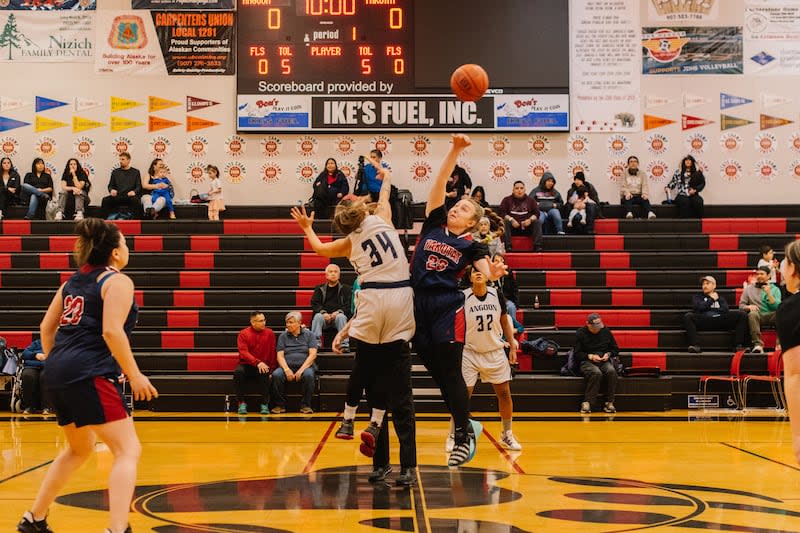
There are only seven miles of road in town, none of them leading in or out. Angoon is connected to Juneau by a floatplane flight or a ferry that runs twice a week every other week. While there is a small grocery store in town, items like toilet paper and bulk food are often flown in (if the weather cooperates). The town relies on three generators, and the ferried-in oil they run on, to power its modest electrical grid.
It’s also home to three basketball gyms. Every night at 7 p.m., students, construction workers, local government officials and even the region’s school superintendent get together for pickup at Angoon High School. It’s less a workout than a hangout — a rotating cast of games to 11 and free-throw competitions.
A few inches off the 3-point arc, Samara Kasayulie-Kookesh finds her spot. Snapping her wrist, she sends synthetic leather through twine, a motion she’s repeated thousands of times. Wearing sweatpants and over-the-ear headphones, Cheyenne kicks the rebound back out to her older sister. Her senior night banner, a white-markered blue poster reading “Cheyenne Kick-Ash,” still hangs in the corner of the high school gym, weeks after her final game for the Angoon Eagles. Catch, shoot, rebound, pass — the pair glide through an almost unconscious hardwood meditation.
“This feels familiar,” says Samara. “Here, I can relax.”
Before transferring to Grand Canyon University, she spent a year playing at Feather River College in California but says the sport started to feel like a job. It was a change from growing up in remote Southeast Alaska, where basketball wasn’t just a game, but “an excuse to come together.”
A few days before Gold Medal, that excuse takes on added importance, each shot from beyond the arc a little closer to the bright lights of Juneau. In a series of pickup games, the Kookesh sisters mix in with the men’s teams, joined by Ramey, as well as Lizzie and Tricia O’Brien, another pair of sisters who reside in Angoon.
The other half of the team will join them in Juneau, with players now scattered between Anchorage, Hoonah and the capital city. A pandemic and slashed transportation budgets have only accelerated the exodus of young people, grounding ferry lines to a near-halt in 2020 and forcing industries that relied on the aging transportation system to circle their wagons in more populated areas.
Carmaleeda Estrada grew up on hand-hung hoops in the village. She moved to Juneau after college in 2007, finding work as an operations officer at the Sealaska Heritage Institute, a Native-run nonprofit focusing on promoting the Tlingit, Haida and Tsimshian cultures of Southeast Alaska. Her parents still live in Angoon, and she makes the trek out every other month, but returning to her hometown doesn’t feel like an option right now. Opportunities are tougher to come by in a town where the unemployment rate is 13.5 percent (nearly triple the state average). It’s not an isolated problem in Southeast Alaska, but it’s a reality that Estrada and many her age have had to contend with over the last decade.
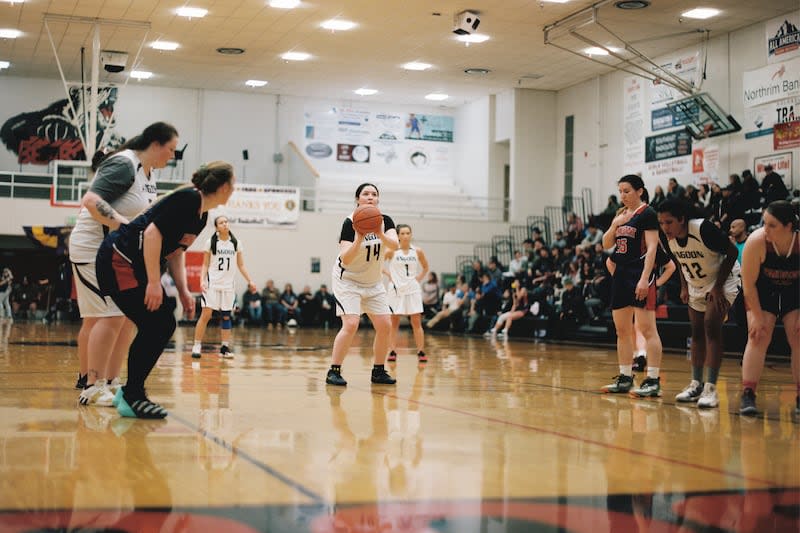
“All of our rural communities have struggles that make it hard to go back,” says Estrada. “Lack of job opportunities, lack of housing and high cost of living are the reasons many people who want to live there can’t. I ended up in Juneau because if I can’t live in Angoon, I still want to be close to home. (This way) I can easily visit my parents or they visit me, or send groceries and supplies when something is needed.”
Estrada wants to see that kind of help go further, to the kids in her community who will soon face the same decisions she did. The Angoon point guard has been raising raffle money to help her teammates cover hotel costs during their week in town and helped the team purchase new jerseys for the tournament. For nearly a decade, she has also been her team’s biggest advocate.
Gold Medal Tournament co-chair Tim Wilson says that while gym space has gotten pricier over the years and budgets are tight, the club will still hand out three to four $1,000 scholarships for each participating community after the tournament, a decadeslong tradition established to help small villages send students to college. “I don’t think people realize this, but most everything we make, we give away,” says Wilson, a Gold Medal player himself.
It’s perhaps this cyclical nature, rather than the annual gathering itself, that has twisted the roots of the tournament so deep around the heart of the communities. At any given game, old-timers like White line the gym’s back wall, admiring a generation that once worshipped them from the bleachers.
“We watched the NBA, but mostly we watched Native tournaments,” says Samara in the grandstands between games. “This is what we looked up to.”
THIS TOURNAMENT IS A RELIGIOUS JOURNEY TO US. MUSLIMS GO TO MECCA. EACH MARCH, WE GO TO JUNEAU.
Angoon’s women’s team is in trouble. Yakutat is moving the ball, and its two-time Alaska high school player of the year, Rose Fraker, is hot. Estrada makes a couple long 3s, but Yakutat’s strong screens and aggressive fast break have stretched the lead to double digits. Samara’s shot is off, and Cheyenne, the youngest player on the court, anxiously searches for passing lanes through bigger bodies.
With the clock ticking under a minute, Cheyenne meets Fraker at halfcourt. Seeing the play in slow motion, her sister creeps up from behind, and as the former all-star picks up her dribble, Samara pokes the ball free. In one motion, Cheyenne takes off. From the top of the grandstands, Albert’s voice booms over the crowd’s crescendo. Grabbing the loose ball, Cheyenne drives into the key and puts the ball calmly off the backboard and in.
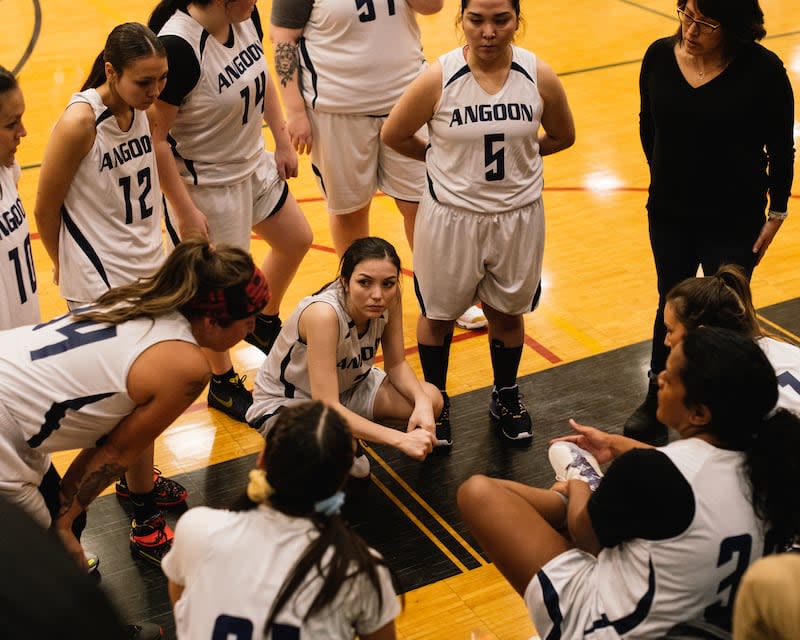
It’s a glimmer of gold in a tournament that will end up bookended by Fraker and her team. Angoon drops its first game, then rallies for two wins against Hoonah and Hake. But they can’t find the answer to Yakutat, falling once again in the Gold Medal semifinals, and ending their tournament. The last Saturday of Gold Medal, the Angoon squad looks on as Prince of Wales finally ends Yakutat’s run, lifting the championship trophy from center court.
The Southeast Alaskan basketball reunion is over as quick as it began. On a mild Sunday, the Kookesh sisters step back on the ship with family, friends and rivals. Dozens move more gingerly than a week ago. Samara still has a few days back in Angoon before she flies back south for spring semester. Cheyenne returns to a looming college decision and high school graduation in the months ahead. But their minds are already back in the Angoon High School gymnasium. Maybe they could get a few shots up tomorrow before the pickup crowd rolls in.
The lights turn on at 7.
This story appears in the March 2024 issue of Deseret Magazine. Learn more about how to subscribe.

